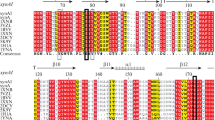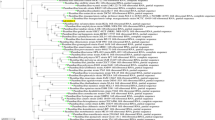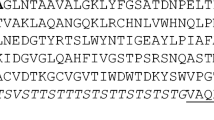Abstract
A new xylanase gene, xynBM4, was cloned from Streptomyces megasporus DSM 41476 and expressed in Pichia pastoris. The full-length gene consists of 1,443 bp and encodes 480 amino acids including a putative 49-residue signal peptide. The deduced amino acid sequence of xynBM4 shows the highest identity of 66.3% to the xylanase Xys1L from Streptomyces halstedii JM8. The purified recombinant XYNBM4 had a high specific activity of 350.7 U mg-1 towards soluble wheat arabinoxylan, exhibited optimal activity at pH 6.0 and 57°C, showed broad pH adaptability (>75% of the maximum activity at pH 2.5–9.0), was resistant to neutral proteases and most chemicals, and produced simple products. The hydrolysis products of birchwood xylan and corncob xylan were predominantly xylobiose (76.9 and 90.8%, respectively) and no xylose. These characteristics suggest that XYNBM4 has potential in various applications, especially in the food industry.




Similar content being viewed by others
References
Arora N, Banerjee AK, Mutyala S, Murty US (2009) Comparative characterization of commercially important xylanase enzymes. Bioinformation 3:446–453
Bradford MM (1976) A rapid and sensitive method for the quantitation of microgram quantities of protein utilizing the principle of protein-dye binding. Anal Biochem 72:248–254
Collins T, Gerday C, Feller G (2005) Xylanases, xylanase families and extremophilic xylanases. FEMS Microbiol Rev 29:3–23
Dhiman SS, Sharma J, Battana B (2008) Industrial applications and future prospects of microbial xylanases: a review. BioResources 3:1377–1402
Goldman N (2009) Methods for optimizing enzymatic hydrolysis of xylan to improve xylooligosaccharide yield. Basic Biotechnol J 5:31–36
Henrissat BA (1991) A classification of glycosyl hydrolases based on amino acid sequence similarities. Biochem J 280:309–316
Himmel ME, Bayer EA (2009) Lignocellulose conversion to biofuels: current challenges, global perspectives. Curr Opin Biotechnol 20:316–317
Laemmli UK (1970) Cleavage of structural proteins during the assembly of the head of bacteriophage T4. Nature 227:680–685
Li N, Meng K, Wang Y, Shi P, Luo H, Bai Y, Yang P, Yao B (2008) Cloning, expression, and characterization of a new xylanase with broad temperature adaptability from Streptomyces sp. S9. Appl Microbiol Biotechnol 80:231–240
Li N, Shi P, Yang P, Wang Y, Luo H, Bai Y, Zhou Z, Yao B (2009) A xylanase with high pH stability from Streptomyces sp. S27 and its carbohydrate-binding module with/without linker-region-truncated versions. Appl Microbiol Biotechnol 83:99–107
Liu YG, Whittier RF (1995) Thermal asymmetric interlaced PCR: automatable amplification and sequencing of insert end fragments from P1 and YAC clones for chromosome walking. Genomics 25:674–681
Miller GL (1959) Use of dinitrosalicylic acid reagent for determination of reducing sugar. Anal Chem 31:426–428
Montané D, Nabarlatz D, Martorell A, Torné-Fernández V, Fierro V (2006) Removal of lignin and associated impurities from xylooligosaccharides byactivated carbon adsorption. Ind Eng Chem Res 45:2294–2302
Moreau A, Roberge M, Manin C, Shareck F, Kluepfel D, Morosoli R (1994) Identification of two acidic residues involved in the catalysis of xylanase A from Streptomyces lividans. Biochem J 302:291–295
Morosoli R, Bertrand JL, Mondou F, Shareck F, Kluepfel D (1986) Purification and properties of a xylanase from Streptomyces lividans. Biochem J 239:587–592
Moure A, Gullon P, Dominguez H, Parajo JC (2006) Advances in the manufacture, purification and applications of xylo-oligosaccharides as food additives and nutraceuticals. Process Biochem 41:1913–1923
Qiu Z, Shi P, Luo H, Bai Y, Yuan T, Yang P, Liu S, Yao B (2010) A xylanase with broad pH and temperature adaptability from Streptomyces megasporus DSM 41476, and its potential application in brewing industry. Enzyme Microb Technol 46:506–512
Ruiz-Arribas A, Sánchez P, Calvete JJ, Raida M, Fernández-Abalos JM, Santamaría RI (1997) Analysis of xysA, a gene from Streptomyces halstedii JM8 that encodes a 45-kilodalton modular xylanase, Xys1. Appl Environ Microbiol 63:2983–2988
Shi P, Tian J, Yuan T, Liu X, Huang H, Bai Y, Yang P, Chen X, Wu N, Yao B (2010) Paenibacillus sp. strain E18 bifunctional xylanase-glucanase with a single catalytic domain. Appl Environ Microbiol 76:3620–3624
Shoseyov O, Shani Z, Levy I (2006) Carbohydrate binding modules: biochemical properties and novel applications. Microbiol Mol Biol Rev 70:283–295
Simpson PJ, Xie H, Bolam DN, Gilbert HJ, Williamson MP (2000) The structural basis for the ligand specificity of family 2 carbohydrate-binding modules. J Biol Chem 275:41137–41142
Vardakou M, Flint J, Christakopoulos P, Lewis RJ, Gilbert HJ, Murray JW (2005) A family 10 Thermoascus aurantiacus xylanase utilizes arabinose decorations of xylan as significant substrate specificity determinants. J Mol Biol 352:1060–1067
Yan Q, Hao S, Jiang Z, Zhai Q, Chen W (2009) Properties of a xylanase from Streptomyces matensis being suitable for xylooligosaccharides production. J Mol Catal B Enzym 58:72–77
Zhou J, Huang H, Meng K, Shi P, Wang Y, Luo H, Yang P, Bai Y, Yao B (2010) Cloning of a new xylanase gene from Streptomyces sp. TN119 using a modified thermal asymmetric interlaced-PCR specific for GC-rich genes and biochemical characterization. Appl Biochem Biotechnol 160:1277–1292
Acknowledgments
This work was supported by the Earmarked Fund for China Modern Agriculture Research System (CARS-42) and the Key Program of Transgenic Plant Breeding (2009ZX08003-020B) and the Agricultural Science and Technology Conversion Funds (2009GB23260444).
Author information
Authors and Affiliations
Corresponding authors
Rights and permissions
About this article
Cite this article
Shi, P., Qiu, Z., Bai, Y. et al. A new xylanase from Streptomyces megasporus DSM 41476 with high yield of xylobiose. World J Microbiol Biotechnol 28, 687–692 (2012). https://doi.org/10.1007/s11274-011-0863-7
Received:
Accepted:
Published:
Issue Date:
DOI: https://doi.org/10.1007/s11274-011-0863-7




